|
ZPACKS ARC BLAST BACKPACK
BY STEVEN M. KIDD
OWNER REVIEW
May 27, 2015
TESTER INFORMATION
|
NAME:
|
Steven M. Kidd
|
|
EMAIL:
|
ftroop94ATgmailDOTcom
|
|
AGE:
|
43
|
|
LOCATION:
|
Carmel, Indiana
|
|
GENDER:
|
M
|
|
HEIGHT:
|
5' 9" (1.75 m)
|
|
WEIGHT:
|
185 lb (83.90 kg)
|
|
PANTS SIZE:
|
34x30 in (86x76 cm)
|
|
BOOT SIZE:
|
Men's US 10.5
|
Backpacking Background: I've been a backpacker on and off for over 30 years. I backpacked as a Boy Scout, and then again almost every month in my twenties, while packing an average weight of 50+ lb (23+ kg). In the last several years I have become a hammock camping enthusiast. I generally go on one or two night outings that cover between 5 to 20 mi (8 - 32 km) distances. I also do several annual outings lasting four to five days covering distances between 15 to 20 mi (24 - 32 km) per day. I try to keep the all-inclusive weight of my pack under 20 lb (9 kg) even in the winter.
PRODUCT INFORMATION
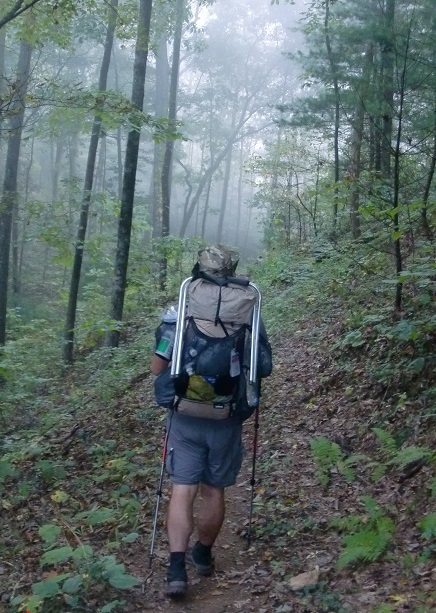 | | ZPacks Arc Blast on the BMT |
Manufacturer: ZPacks LLC
Year of Manufacture: 2012
Manufacturer's Website: http://www.zpacks.com
MSRP: US $295
Listed Base Weight: 17 oz (482 g)
Listed Volume: 52 L (3200 cu in) *
*Website lists pack at 3200 cu in, my conversion is 3173 cu in
The Arc Blast is a customizable external frame backpack constructed with a 2.92 oz/sq yd (99 g/sq m) Cuben Hybrid fabric. This material is Cuben Fiber on the inside with a protective layer of 50 denier Polyester on the outside. It is designed to handle loads up to 30 lb (14 kg). The pack uses a patent pending flexed arc carbon fiber frame and a mesh panel designed to create an air gap between the back and the pack. It is offered in three sizes and the pack I own is the 52 L (3173 cu in) original default size.The pack is also offered in 45 L (2746 cu in) and 60 L (3661 cu in) sizes.
Standard features on the Arc Blast include a roll top closure and strap, padded contoured shoulder straps, a padded hip belt, large side pockets designed to accommodate bottles up to 1.5 L (51 fl oz), a hydration port, side compression straps and a large mesh pocket on the front of the pack. The pack may also be customized with at least ten additional options. I've customized my Arc Blast by adding load lifter straps, belt pouches, top side pockets and shock cord lashing on the front of the pack. Each of these items adds overall weight to the pack, but several options add incremental volume as well. In all my options add 3.4 oz (96 g) to the packs weight, but I also gained a little over 5 L (312 cu in) in available volume.
ZPacks has made a few minor changes to the Arc Blast since I purchased my version in the fall of 2012. The hydration port and side compression straps were not available when I bought my version, as well as some minor adjustments in how the carbon frame is attached. They also now seal the pack seams. Those minor additions now bring the pack base weight to the above mentioned 17 oz (482 g). The base weight of my pack is 13 oz (369 g) and the overall weight with my options is just at 16.4 oz (465 g) However, one great feature offered when dealing with ZPacks is their willingness to update an older version. I'm in the process of returning my pack to be retrofitted.
FIELD USE
Since purchasing the Arc Blast I have used it as my primary pack on extended distance treks ranging from three to six days since acquiring it. I've definitely used the pack on many more outings than listed below, but following is a sampling of some higher mileage trips:
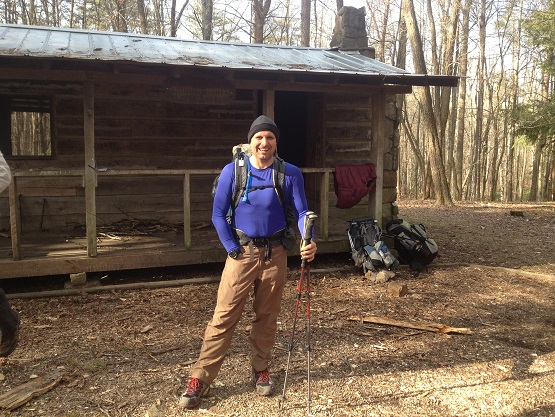 | | Hobbs Cabin - March, 2013 |
7-10 March, 2013: The Savage Gulf, South Cumberland State Park, Tennessee. This was a 4 day, 3 night 'group hang' with 25 hammock campers covering 23 miles (37 km). On the first evening temperatures dropped to as low as 22 F (-5.5C), but by the final day temperature were rose as high as 63 F (17 C). Elevations ranged from 1100 ft (335 m) in the gulf to 1850 ft (564 m) on the rim. On the final evening, although the temperatures were balmy compared to the first night or two, the winds did blow as high as 30 mph. Winds like these can easily affect hammock campers as there is 360 degree air circulation.
3 - 6 October, 2013; Benton MacKaye Trail along the Tennessee and North Carolina state line. This trip was originally planned to take place in the Great Smokey Mountain Park, but government interference required a last minute change of plans. We therefore routed a 56 mi (90 km) 4-day and 3-night trip along the BMT starting in Reliance, TN at an elevation of 792 ft (241 m) to Beech Gap, NC. The max elevation on the scheduled route was 5080 ft (1548 m) at Whigg Meadow. At the end of day three after two up and downs and a summit of 4090 ft (1246 m) we descended to the Tellico River and one of my backpacking buddy's knees was toast. We were fortunate enough to hitch a ride with a hunter back to our drop car and made our way back to the base camp at our starting point in Reliance. This cut our distance traveled to a little over 43 mi (62 km). This first weekend of October was unseasonably warm for the Cherokee National Forest. The coolest temperature I measured was 48 F (9 C) and it reached over 82 F (28 C) one afternoon.
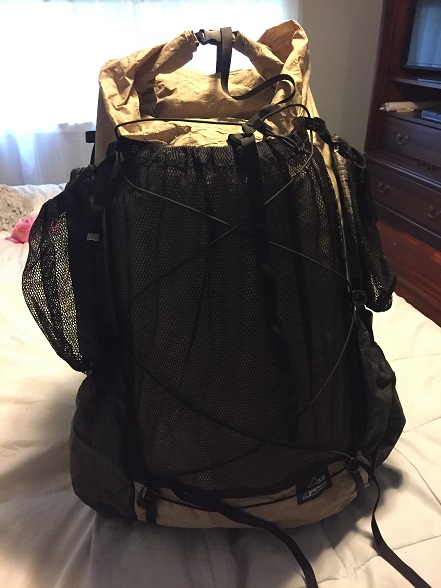 | | Notice the Rolled Top & Mesh Pocket |
7 - 10 October, 2014; Pine Mountain Trail, eastern Kentucky and western Virginia. This was a 4-day/3-night outing in which I met up with six hammock camping buddies at the Birch Knob Observation Tower shelter and hiked to the trailhead in Elkhorn City, Kentucky. The rest of my comrades had already been on the trail for three days encountering torrential downpours and extremely steep climbs. This caused three of the crew to take a time-out and remain at the shelter for the final leg of the trip. Four of us set out on the next morning and covered 14 mi (22.5 km) over the next two days. Elevations ranged from roughly 2800 ft (853 m) to around 800 ft (244 m) just outside of town. After emerging from the trail we were shuttled back to the tower for a final night in the woods. Temperatures on the trail were as high as 75 F (24 C) and conditions were bright and sunny. On the evenings in base camp temperatures dropped to around 45 F (7 C) and poured rain on and off.
8 - 12 April, 2015; South Cumberland State Park, Savage Gulf and Stone Door Region of the Lower Cumberland Plateau in Middle Tennessee. Some backpacking buddies and I had a trip planned over these dates for the Big South Fork area of Tennessee and Kentucky. Late winter ice storms had the trails in that area in really rough shape, so we had to make an ad hoc decision and this was the next most central location for the six of us. It was five-day/four-night trip that covered both sides of the natural area covering close to 41 mi (66 km). Elevations ranged from around 1800 ft (549 m) on the plateau to just under 1300 ft (396 m) in the gulf. The high temperature for the outing was on the second day of hiking reaching 86 F (30 C). It was around 66 F (19 C) the first two evenings until a front with a storm came through cooling the temperatures over the next several days. Daytime temperatures continued to rise into mid- 70's F (24 C), but the low on both Friday and Saturday night dropped to 40 F (4.5 C). Both those nights were so clear and starlit that I didn't even deploy my tarp on the final evening. Terrain varied from level and easy to traverse on the plateau to extremely rocky, slick and slow going on the ascents and descents. The drops into and climbs out of the gulf generally only last 0.25 - 0.5 mi (0.4 - 0.8 km), however, they were steep and intense and we generally found them fairly strenuous.
IMPRESSIONS
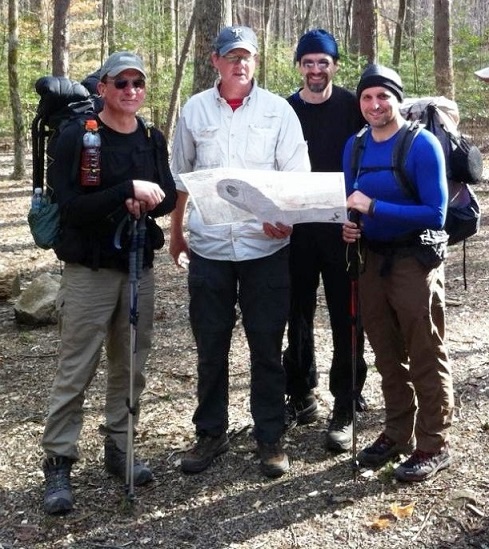 | | Side View of the Arc Blast |
My comments on the Arc Blast are nothing shy of ecstatic jubilation! I have been thoroughly impressed with this pack since first acquiring it. In the fall of 2012, I was on a backpacking trip with group of about 25 hammock campers and one member of our party had this pack. I looked it over, tried it on decided I had to have one. I ordered it as soon as I returned home. As the pack is one large compartment I decided it would make sense for me to add several accessories. Load lifters were not even an option for me, I had to have them. I also ordered the pack with hip belt pockets and top side mesh pockets and have found both to be very useful.
I often store items I like quick access to in the hip pockets. Typically items like energy bars, a small knife, a bandana and the like. In the mesh top pockets I often store my cook pot and stove, water filtration and meals for the trail. This way if I decide to stop for a hot meal I don't have to actually dig into the body of the pack. However, if there is an item I need it isn't hard at all to access the compartment. There is a cinch strap and a roll top closure and this closure also has a hook and loop closure. When I am closing the pack I do try to expel the majority of the air from the interior before sealing the hook and loop. The pack material will allow it to escape as I roll it, but I find it easier to do so before.
The large mesh pocket that covers the majority of the front panel is a great catch-all for lightweight items. I often keep my rain gear, first aid kit and empty hydration bladders in this pocket. If my rain fly is wet I will usually keep it here as well. The main compartment is generally reserved for my sleep gear, hammock, clothing and food. As I mentioned the newest version offers a hydration port on the back panel. I use a two liter hydration bladder that tucks into one of the large side pockets. I attach it to a sewn loop on the upper portion of the pack with an s-biner and fish the hose up and attach it to my shoulder strap with another carabiner. This method works very well for me and I prefer not to actually have a bladder inside my pack just in case of a catastrophic failure. My bedding is stored in a dry bag, but there is nothing worse than opening a pack to see all your inner gear soaked! It's never personally happened to me, but I've seen the aftermath when looking into a peer's mishap.
I've used this backpack with weights ranging from 18 - 30 lb (8 - 14 kg) and I've never had an uncomfortable load. In fact, I may have stopped to repack it a maximum of two or three times because the load wasn't feeling right on my back. For me, that is an excellent ratio. I've also used in on flat trails and extreme climbs. During the trip on the Benton MacKaye Trail I had some pretty serious climbs with limited access to water, so I was carrying an average of 5 L (5.25 qt) of water at a time. The pack handled this additional load quite well in my opinion.
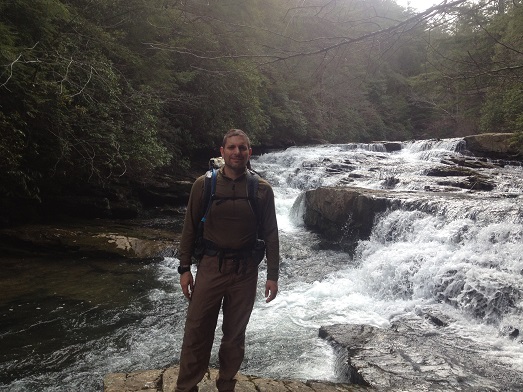
What is the ultimate compliment that I can give the Arc Blast? It sounds a little silly, but here goes...I was "Roched" into it and I've since "Roched" two other buddies into purchasing the same pack! To explain, Roche is the trail name for a buddy of mine that always shows up to a group event with a shiny new gadget and everyone just has to have. Hence, one gets "Roched" into buying an item. Well, after a trip to Big South Fork and seeing one in 2012 I just had to have it. After I'd shown my pack to two other friends soon thereafter they felt the same way.
So far durability has not been a concern of mine with the pack. I do take extra care with it since it is designed with very lightweight materials that I believe to be somewhat more delicate than an average pack. Most of the cinch straps for the main bag, attachment points and sternum strap are made with a 3/8 in (1 cm) ribbon-like material. The buckles and clasps are made with of lightweight components. I personally have never had an issue, but I was on the trail with those two buddies that I "Roched" into the packs and one cinched down quick and hard on his shoulder strap breaking a buckle. He had to tie it off for the remainder of the trip. He claimed it was a 'bone-headed' move and was his own fault and when I saw him for again for an outing this spring he was delighted with the customer service her received from ZPacks. This is second hand knowledge, but I was with him when he snapped the buckle and he even mentioned that Joe at ZPacks didn't charge return shipping after the repair.
Overall, I'm thoroughly impressed with the Arc Blast. As mentioned I'm about to ship mine off to retrofit with side compression and to update the carbon fiber attachment points. I also plan on purchasing the chest pouch and lumbar pad during the transaction. Why? I was "Roched" into both of them!
This report was created with the BackpackGearTest.org Report Writer Version 1.
Copyright 2015. All rights reserved.
Read more reviews of ZPacks gear
Read more gear reviews by Steven M Kidd
|




